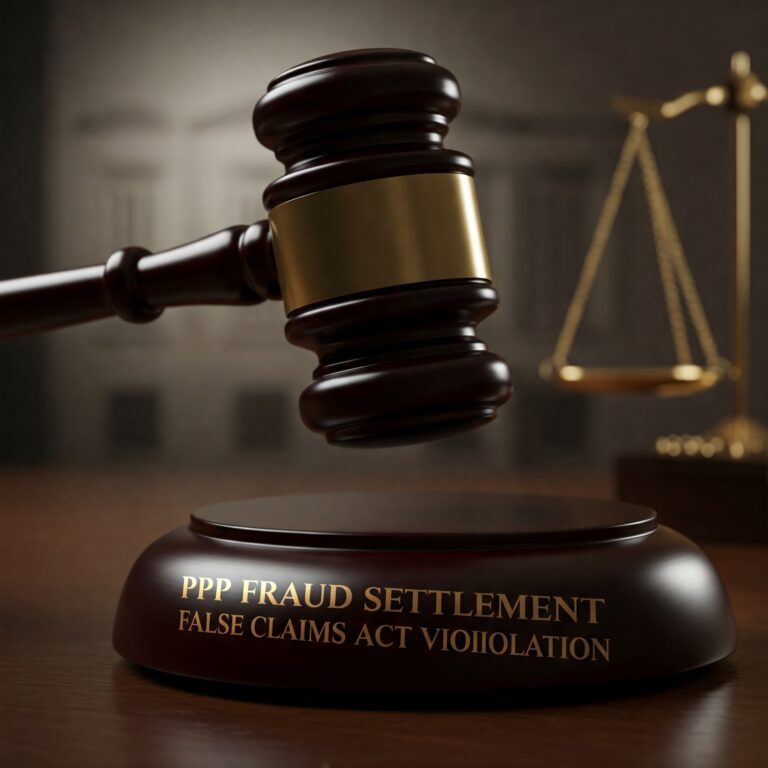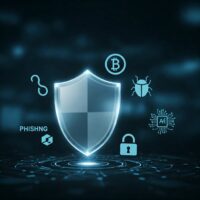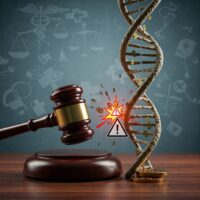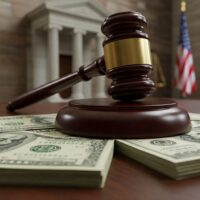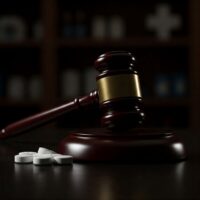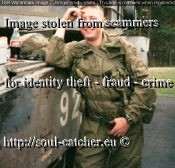DETROIT, MI – A Sterling Heights, Michigan electrical contracting firm, Slifco Electric, LLC, and its sole owner, John P. Slifco, have agreed to pay $1,460,062 to the United States government to resolve allegations of violating the False Claims Act (FCA). The settlement, announced by the Acting United States Attorney for the Eastern District of Michigan, addresses claims that the company falsely certified its eligibility for full forgiveness of a multi-million dollar Paycheck Protection Program (PPP) loan while failing to disclose significant capital distributions made to its owner.
This case emerges amidst a nationwide crackdown on fraud related to the massive COVID-19 relief programs, highlighting the government’s use of the powerful False Claims Act to recoup taxpayer funds and enforce program rules. The settlement underscores the critical importance of accurate certifications made by businesses seeking loan forgiveness under the PPP, particularly concerning rules limiting owner compensation.
The resolution stems from allegations that Slifco Electric, after receiving a substantial PPP loan intended to support payroll and essential business expenses during the pandemic’s economic turmoil, made hundreds of thousands of dollars in payments to Mr. Slifco for personal expenses. Crucially, the government contends these distributions were not disclosed when the company applied for and certified its eligibility for complete forgiveness of the taxpayer-backed loan. The settlement was reached following an investigation involving the U.S. Attorney’s Office for the Eastern District of Michigan (USAO-EDMI) and the Small Business Administration (SBA), the agency responsible for administering the PPP. While the settlement resolves the government’s allegations, it does so without a formal determination of liability against Slifco Electric or its owner.
Unpacking the Slifco Electric Settlement: Allegations and Resolution
The core of the government’s case against Slifco Electric, LLC, a Michigan-based electrical contractor, and its owner, John P. Slifco, centered on actions taken after securing significant financial assistance through the Paycheck Protection Program.
The Parties and the Loan: Slifco Electric, headquartered in Sterling Heights, Michigan, is described as a full-service electrical contracting company founded in 2005. John P. Slifco is identified as the sole owner of the business. In April 2020, as the economic impacts of the COVID-19 pandemic were rapidly unfolding, Slifco Electric obtained a First Draw PPP loan amounting to $2,633,170. These funds were part of the unprecedented federal effort to stabilize small businesses and preserve employment.
The Alleged False Certification: The government’s allegations focused on the loan forgiveness stage of the PPP process. To have the loan forgiven, borrowers were required to submit an application and certify, under penalty of law, that the information provided was true and correct and that the funds were used according to program rules. The United States alleged that Slifco Electric submitted such a certification, seeking full forgiveness of its $2.63 million loan, but that this certification was false.
Undisclosed Capital Distributions: The basis for the alleged falsity was the government’s claim that Slifco Electric failed to disclose substantial payments made to its owner. Specifically, the government alleged that from March 13, 2020, through the end of the loan forgiveness covered period, the company paid $730,031 in capital distributions to John P. Slifco for his personal expenses. This period notably began shortly before the PPP was officially enacted, suggesting investigators examined financial activities surrounding the loan’s disbursement and forgiveness period. These alleged distributions far exceeded the strict limits the PPP placed on forgivable compensation for business owners.
The Settlement Agreement: To resolve these allegations, Slifco Electric agreed to pay $1,460,062 to the federal government. This payment settles the claims brought under the False Claims Act. A significant aspect of this resolution, common in FCA settlements, is the explicit disclaimer that the agreement resolves allegations only, and there has been no determination of liability. This means that while Slifco Electric paid a substantial sum to end the legal dispute, it did not formally admit to wrongdoing as part of the settlement. Such agreements allow both parties to avoid the costs and uncertainties of litigation.
The settlement amount itself warrants attention. At $1.46 million, it is almost precisely double the $730,031 in alleged improper distributions. The False Claims Act allows the government to recover up to three times its actual damages (treble damages) plus significant per-claim penalties. While settlements often involve negotiation below the maximum potential liability, the approximate 2x multiplier in this case strongly suggests the payment includes not only the recovery of the allegedly misused funds but also a substantial penalty component, reflecting the punitive aspect of the FCA. This structure is consistent with FCA settlement practices observed in other PPP-related cases, where multipliers between 1.5x and 2x have been noted.
Official Reactions: Government officials framed the settlement as a matter of taxpayer protection and accountability. Acting U.S. Attorney Julie A. Beck stated, “When businesses and individuals obtained COVID-19 relief funds that they didn’t deserve, taxpayers were cheated. This office is committed to addressing fraud perpetrated against government programs, and we will continue to hold accountable those who violate the law”.
SBA General Counsel Wendell Davis highlighted the collaborative nature of enforcement efforts, noting, “The favorable settlement in this case is the product of enhanced efforts by federal agencies such as the Small Business Administration working with the U.S. Attorney’s Office, SBA’s Office of Inspector General and other Federal law enforcement agencies, as well as private individuals who uncover fraudulent conduct to recover the product of this fraud as well as penalties”. His mention of private individuals points towards the potential role of whistleblowers, who are empowered under the FCA’s qui tam provisions to bring fraud suits on behalf of the government.
The investigation was handled by Assistant U.S. Attorney Anthony Gentner from the USAO-EDMI, with assistance from the SBA’s Office of General Counsel.
The Paycheck Protection Program (PPP): An Emergency Lifeline with Strings Attached
The Paycheck Protection Program emerged as a cornerstone of the U.S. government’s immediate economic response to the COVID-19 pandemic. Understanding its structure, goals, and rules is essential to grasping the context of the Slifco Electric settlement.
Genesis and Purpose: Enacted in late March 2020 as part of the massive Coronavirus Aid, Relief, and Economic Security (CARES) Act , the PPP was designed as an emergency measure. Its primary objective was to provide a direct incentive for small businesses to keep their workers on the payroll and cover critical operating expenses during widespread shutdowns and economic uncertainty. Billions of dollars were allocated to provide potentially forgivable loans, acting as a financial bridge for businesses struggling with pandemic-induced revenue losses.
Administration and Structure: The program was implemented by the Small Business Administration (SBA), with support from the U.S. Department of the Treasury. Unlike direct government grants, PPP funds were disbursed as SBA-guaranteed loans processed through participating private lenders, such as banks, credit unions, and other financial institutions. This structure allowed for rapid deployment of funds but also created a complex system involving borrowers, lenders, and the SBA itself. The program officially stopped accepting new applications on May 31, 2021.
Loan Basics and Eligibility: PPP loans were offered with attractive terms, including no initial requirement for collateral or personal guarantees. The program targeted a broad range of small entities, generally those with 500 or fewer employees, including non-profits, veterans organizations, tribal businesses, sole proprietorships, self-employed individuals, and independent contractors.
Use of Funds and the Forgiveness Incentive: The defining feature of the PPP was the potential for full loan forgiveness, effectively turning the loan into a grant if specific conditions were met. To qualify for forgiveness, borrowers had to use the loan proceeds primarily for payroll costs (including salaries, wages, benefits, and state/local payroll taxes). Funds could also be used for other eligible expenses like business mortgage interest payments, rent or lease payments, and utility payments.
A crucial rule that evolved was the requirement that at least 60% of the amount sought for forgiveness must have been used for eligible payroll costs. Failing to meet this threshold would result in a proportional reduction in the forgiveness amount.
The Covered Period: Expenditures eligible for forgiveness had to be incurred or paid within a specific timeframe known as the “Covered Period”. Borrowers generally could choose between an 8-week or a 24-week period starting from the date they received the loan funds. This period became the critical window for tracking and documenting eligible expenses.
Documentation and Compliance: The onus was on the borrower to meticulously document their use of PPP funds to support their forgiveness application. This included providing payroll records, tax filings, bank statements, lease agreements, utility bills, and other evidence of eligible payments. Borrowers were required to retain these records for six years after the loan was forgiven or repaid.
The program’s rapid deployment, coupled with evolving rules and guidance issued iteratively by the SBA and Treasury , created an environment ripe for both confusion among borrowers and exploitation by fraudulent actors. The initial push for speed, urging businesses to “apply as quickly as you can” , arguably led to less stringent upfront controls. This dynamic contributed to what the SBA’s Office of Inspector General (OIG) later characterized as a “pay and chase” scenario, where funds were disbursed quickly, leaving enforcement agencies to pursue fraudulent or ineligible recipients after the fact. Government Accountability Office (GAO) reports confirmed that comprehensive anti-fraud measures were not fully implemented until a significant portion of PPP and related EIDL funds had already been disbursed , highlighting an inherent tension between the urgent need for economic relief and the imperative of program integrity.
Furthermore, the program’s reliance on lenders for initial processing and the SBA for ultimate forgiveness approval created potential gaps in oversight. While lenders verified basic application details, the SBA’s forgiveness review, particularly for smaller loans or those using simplified forms like the 3508S or 3508EZ , may have focused more heavily on validating the use of funds for eligible expenses rather than rigorously re-examining the initial eligibility certifications. This potential disconnect could allow initial misrepresentations, such as those alleged in the Slifco case regarding compliance certifications, to proceed through the forgiveness process unless specifically flagged for audit.
Spotlight on PPP Forgiveness: Certifications and Owner Compensation Rules
The loan forgiveness application was the gateway to converting a PPP loan from debt into a grant, making the certifications and rules governing this process critically important – and a major focus for fraud enforcement.
The Forgiveness Application Process: Borrowers seeking forgiveness had to formally apply through their PPP lender. The specific form used – SBA Form 3508, 3508EZ, or 3508S – depended primarily on the loan amount and whether the borrower met certain criteria related to maintaining employee headcount and wages. The EZ and S forms offered simplified processes for eligible borrowers, particularly those with smaller loans.
The Critical Certification: Regardless of the form used, a core component was the borrower’s certification. The authorized representative of the business had to certify, under penalty of law including potential prosecution for false statements (18 U.S.C. § 1001 and § 3571), that:
- The information provided in the application and supporting documents was true and correct in all material respects.
- The amount requested for forgiveness was used to pay costs eligible under PPP rules (payroll, mortgage interest, rent, utilities, etc.).
- The funds were used to retain employees.
- They understood that knowingly making a false statement to obtain forgiveness was punishable by law.
This legally binding certification placed the responsibility for accuracy and compliance squarely on the borrower. It became the lynchpin for subsequent False Claims Act cases, as making a false certification to obtain government funds (in this case, loan forgiveness) falls directly within the FCA’s scope.
Owner Compensation vs. Capital Distributions: A Crucial Distinction: A particularly complex area, and central to the Slifco allegations, involved how business owners could pay themselves with PPP funds. The rules drew a sharp distinction between potentially forgivable “owner compensation” and generally non-forgivable “capital distributions” or “owner draws.”
- Eligible Owner Compensation: The PPP allowed forgiveness for compensation paid to owners who actively worked in their business. However, this was subject to strict limitations designed to prevent owners from disproportionately benefiting from the program compared to their employees.
- Compensation Caps: For borrowers using the standard 24-week covered period, the maximum forgivable compensation per owner, across all businesses they owned, was capped at the lower of:
- $20,833 (representing 2.5 months’ worth of a $100,000 annual salary).
- The 2.5-month equivalent of their applicable compensation from 2019 or 2020 (the year used to calculate their initial loan amount).
- (For an 8-week covered period, the cap was lower, typically $15,385).
- The specific calculation and inclusion of benefits (like health insurance or retirement contributions) varied slightly depending on the business structure (C-corporation, S-corporation, sole proprietor, general partner). Notably, owner-employees holding less than a 5% ownership stake in C- or S-corporations were generally exempt from these specific caps.
- Capital Distributions/Owner Draws: Payments representing a distribution of business profits or a return on equity investment (capital distributions), rather than compensation for services rendered based on prior earnings history, were generally not considered eligible payroll costs for forgiveness. The PPP was intended to support operational expenses like payroll, not to fund owner payouts beyond the established compensation limits. The specific allegation against Slifco involved “$730,031 in capital distributions… for Mr. Slifco’s personal expenses,” clearly framing these payments as outside the scope of forgivable owner compensation.
The Alleged Conflict in the Slifco Case: The government’s case against Slifco Electric rested on the alleged contradiction between its certification of compliance for full loan forgiveness and the undisclosed $730,031 in capital distributions paid to John Slifco. This amount vastly exceeded the $20,833 maximum allowable owner compensation forgiveness for a single owner over a 24-week period. The act of certifying compliance while allegedly making these large, undisclosed, and ineligible payments formed the basis of the False Claims Act allegations.
The distinction between capped, forgivable “owner compensation” tied to work and prior earnings, and potentially non-forgivable “capital distributions” representing profit or equity payouts, is therefore fundamental. The government’s specific use of the term “capital distributions” signals that these payments were viewed as distinct from, and ineligible under, the program’s payroll cost rules. This makes the alleged false certification particularly stark – attesting that funds were used properly while allegedly making substantial owner payouts that violated program limits.
Furthermore, the legal requirement for borrowers to certify compliance under penalty of law effectively transferred significant legal risk onto the business owner. Regardless of potential flaws or oversights in the SBA’s or lender’s review process , the act of submitting an inaccurate certification provided a direct basis for FCA liability. This underscores the critical burden placed on borrowers to fully understand and adhere to the intricate PPP regulations.
Table: PPP Owner Compensation Forgiveness Caps (Illustrative – 24-Week Covered Period)
| Owner Type | Maximum Forgivable Cash Compensation Per Individual | Basis for Cap | Key Considerations / Exclusions |
|---|---|---|---|
| Owner-Employee (C-Corp, >5% stake) | $20,833 | Lower of $20,833 OR 2.5/12 of 2019/2020 cash compensation | Eligible for separate forgiveness of employer retirement & health insurance contributions (within limits). |
| Owner-Employee (S-Corp, >5% stake) | $20,833 | Lower of $20,833 OR 2.5/12 of 2019/2020 cash compensation | Eligible for separate forgiveness of employer retirement contributions. Health insurance contributions generally NOT separately forgivable (already in cash comp). |
| Sole Proprietor (Schedule C Filer) | $20,833 | Lower of $20,833 OR 2.5/12 of 2019/2020 net profit (Owner Compensation Replacement) | No separate forgiveness for health insurance or retirement contributions (paid from net self-employment income). |
| General Partner | $20,833 | Lower of $20,833 OR 2.5/12 of 2019/2020 net earnings from self-employment (x 0.9235) | No separate forgiveness for health insurance or retirement contributions (paid from net self-employment income). |
| Owner-Employee (C- or S-Corp, <5% stake) | $46,154 (Standard Employee Cap) | Prorated portion of $100,000 annual salary over 24 weeks | Not subject to the specific owner-employee caps ($20,833 limit does not apply). |
Export to Sheets
Note: This table summarizes general rules applicable during much of the program; specific calculations could vary based on loan date, chosen covered period, and evolving guidance. Sources: scheffelboyle.com , americanriviera.bank
The False Claims Act (FCA): The Government’s Primary Anti-Fraud Tool
The False Claims Act serves as the federal government’s principal legal weapon for combating fraud against its programs, including the massive relief efforts enacted during the COVID-19 pandemic. Its provisions explain the legal basis for the Slifco Electric settlement and the significant financial stakes involved.
Purpose and Origins: Originally enacted in 1863 during the American Civil War to address defense contractor fraud, the FCA (codified at 31 U.S.C. §§ 3729-3733) imposes civil liability on any person or entity who knowingly submits, or causes the submission of, false or fraudulent claims for payment to the U.S. government. Its reach extends beyond direct false billings to include using false records or statements material to a false claim, conspiring to commit fraud, and improperly avoiding obligations to pay money to the government (known as “reverse false claims”).
The “Knowing” Standard: A key feature of the FCA is its definition of “knowing.” Liability does not require proof of specific intent to defraud. Instead, the standard is met if a person or entity:
- Has actual knowledge that the information is false;
- Acts in deliberate ignorance of the truth or falsity of the information; or
- Acts in reckless disregard of the truth or falsity of the information.
This broad definition, particularly the inclusion of “reckless disregard” and “deliberate ignorance,” makes it significantly easier for the government to establish liability compared to criminal fraud standards requiring proof beyond a reasonable doubt. In the context of complex programs like the PPP, where borrowers certified compliance with intricate and sometimes evolving rules, this standard is particularly relevant. Signing a certification without conducting adequate due diligence to ensure its accuracy could potentially be viewed as reckless disregard, even absent malicious intent.
Severe Financial Penalties: Violating the FCA carries substantial financial consequences designed to deter fraud and compensate the government:
- Treble Damages: Defendants found liable are typically required to pay three times the amount of the government’s actual damages resulting from the false claim.
- Per-Claim Penalties: In addition to treble damages, the FCA mandates a separate civil penalty for each false claim submitted. This means that if multiple false invoices, applications, or certifications were submitted, penalties can accumulate rapidly.
- Inflation Adjustments: These per-claim penalties are adjusted annually for inflation. For violations assessed after June 19, 2020 (relevant to the timing of many PPP forgiveness applications), the penalty range was $11,665 to $23,331 per claim. For penalties assessed after December 13, 2021, the range increased to $11,803 to $23,607 per claim. (These penalties have continued to rise in subsequent years ).
The combination of mandatory per-claim penalties and treble damages creates significant financial exposure for defendants. This potential for massive liability provides the government with powerful leverage to negotiate substantial settlements, often without the need for a trial or an admission of liability from the defendant, as seen in the Slifco case.
Qui Tam (Whistleblower) Provisions: A unique and powerful aspect of the FCA is its qui tam provision, which allows private citizens (known as “relators”) with knowledge of fraud against the government to file a lawsuit on the government’s behalf. If the lawsuit is successful, the relator is entitled to receive a portion of the government’s recovery, typically ranging from 15% to 30%. This financial incentive encourages individuals with inside information about fraud to come forward. A significant number of FCA cases, including many related to PPP fraud, originate as qui tam suits. The government has the option to intervene and take over the litigation; if it declines, the relator may proceed with the case independently.
Settlements and “Allegations Only”: As noted previously, FCA cases are frequently resolved through settlements rather than trials. These settlements typically include language stating that the payment resolves allegations only and does not constitute an admission or determination of liability. This allows the government to recover funds efficiently while defendants avoid the risk and expense of litigation and a formal finding of wrongdoing.
Connecting the Dots: How the FCA Applies to PPP Loan Forgiveness Fraud
The framework of the False Claims Act provides a direct mechanism for the government to pursue cases like the one involving Slifco Electric, specifically targeting misrepresentations made during the PPP loan lifecycle.
False Statements as False Claims: Submitting a PPP loan application or, critically, a loan forgiveness application containing false information can trigger FCA liability. Certifying eligibility based on false premises (e.g., incorrect employee counts, misrepresenting ownership structure) or falsely attesting to compliance with program rules during the forgiveness stage (e.g., regarding the use of funds, maintenance of payroll, or adherence to owner compensation limits) can constitute either a “false claim” for government funds (the loan or its forgiveness) or a “false statement material to a false claim” under the FCA.
The Materiality Requirement: For a false statement to be actionable under the FCA, it must be “material.” This generally means the statement had a natural tendency to influence, or was capable of influencing, the government’s decision-making process – in this context, the SBA’s decision to approve a PPP loan or, more pointedly, to grant forgiveness. Certifications regarding core eligibility requirements or compliance with fundamental program rules, such as how funds were spent or the limits on owner payouts, are almost always considered material to the decision to forgive a loan.
Application to the Slifco Case: In the Slifco matter, the government alleged that the company’s certification on its forgiveness application – attesting it was eligible for full forgiveness and had complied with program rules – was false because of the $730,031 in undisclosed capital distributions to the owner. This alleged false statement was deemed material because, had the true nature and extent of these distributions been known, the government argues Slifco Electric would not have been eligible for the full forgiveness it sought. The act of submitting this allegedly false certification to obtain forgiveness (a financial benefit from the government) directly implicates the FCA.
The focus on the forgiveness stage in many PPP enforcement actions, including Slifco’s, is significant. Even if a business initially received a loan based on seemingly valid information (or information that wasn’t deeply scrutinized at the time), the subsequent forgiveness application provided a separate, distinct opportunity to make representations about actual fund usage and compliance during the covered period. False statements made at this critical juncture, when the borrower is asking the government to convert the loan into a grant, carry substantial weight and provide a clear basis for FCA liability. This underscores that the certification process was not a mere formality but a high-stakes attestation of compliance.
Furthermore, the FCA’s reach can extend beyond deliberate falsehoods. The “reckless disregard” or “deliberate ignorance” components of the “knowing” standard mean that borrowers who perhaps exploited ambiguities in the rules, failed to seek clarification on complex requirements like owner compensation, or neglected to correct known errors in their applications before certifying could potentially face liability. The first-ever civil PPP fraud settlement involving SlideBelts exemplified this, where the company and its CEO admitted to falsely certifying they were not in bankruptcy, despite knowing this was incorrect, highlighting the risk associated with proceeding despite known inaccuracies.
Company Profile: Slifco Electric, LLC
Understanding the business at the center of the settlement provides further context for the allegations. Slifco Electric, LLC, appears to be a well-established player in the electrical contracting industry, particularly in the demanding automotive sector.
Establishment and Leadership: The company was founded in 2005 by John P. Slifco, described on the company website as a 30-year industry veteran. Mr. Slifco remains the sole owner of the Sterling Heights, Michigan-based firm. The company emphasizes values of hard work, honesty, and integrity under his leadership.
Services and Market Focus: Slifco Electric operates as a full-service electrical contracting company. Its core focus lies in complex automotive and heavy industrial installations, but its service offerings extend to commercial projects, low voltage systems, specialty electrical work, and utility contracting. Capabilities include standard electrical contracting, construction and general contracting, pre-fabrication in its own facilities, design/build engineering, and ongoing service support.
Scale and Reach: The company operates from an expansive 50,000-square-foot headquarters in Sterling Heights, Michigan. Its reach extends across North America , underscored by its licensing in 43 states and a significant satellite operation established in Liberty, North Carolina. This 100,000-square-foot North Carolina facility was opened specifically to support its role as the primary electrical contractor for a major new Toyota battery manufacturing plant. Slifco Electric employs licensed union electricians, maintaining partnerships with numerous International Brotherhood of Electrical Workers (IBEW) locals across multiple states.
Clients and Reputation: Slifco Electric promotes itself as an industry leader committed to high standards, quality work, and customer satisfaction. Its project portfolio includes work for major corporations, prominently featuring automotive giants like Toyota, General Motors, Ford, and Mazda, as well as industrial firms and commercial developers.
Financial Context (PPP): Against this backdrop of substantial operations, Slifco Electric applied for and received the $2,633,170 PPP loan in April 2020.
The profile of Slifco Electric as a long-standing, seemingly successful business with major corporate clients contrasts sharply with many PPP fraud cases involving shell companies or identity theft. This suggests the alleged violation may stem less from outright fabrication and more from a potential misapplication, misunderstanding, or disregard of specific, complex program rules – namely, the limitations on owner distributions and the requirement for truthful certification during forgiveness. The company’s public emphasis on “honesty and integrity” stands in stark contrast to the government’s allegations of false certification, highlighting the significant reputational damage that can accompany such settlements, even when liability is not formally admitted.
Analyzing the Allegations: Distributions vs. Forgiveness Rules
The specific financial details alleged by the government paint a picture of potential conflict with core PPP forgiveness requirements.
The Core Conflict: The key elements are:
- A $2,633,170 PPP loan obtained.
- A subsequent application for full forgiveness of this amount.
- A required certification attesting to compliance with all PPP rules.
- An alleged failure to disclose $730,031 in “capital distributions” paid to the sole owner, John P. Slifco, for personal expenses during the relevant period.
Violation of Owner Compensation Caps: The alleged distribution amount of $730,031 is dramatically higher than the maximum forgivable compensation allowed for a single owner under the PPP rules. As established, the cap for a 24-week covered period was $20,833 per owner. The sheer scale of the alleged distributions ($730k vs $21k cap) makes it difficult to argue they represented permissible, forgivable owner compensation under the program’s guidelines.
Nature of “Capital Distributions for Personal Expenses”: The government’s specific description of the payments as “capital distributions” used for “personal expenses” is legally significant. It implies these funds were treated as withdrawals of business profit or equity by the owner, rather than as salary or wages earned for services rendered during the covered period, which is the basis for forgivable payroll costs. PPP funds were intended to cover operational costs like employee payroll and rent, not to facilitate large owner payouts exceeding program limits.
The False Certification Link: The crux of the FCA violation alleged by the government is not merely the act of making the distributions, but the act of falsely certifying compliance on the forgiveness application despite these distributions having occurred. By seeking full forgiveness while allegedly concealing these substantial, potentially ineligible owner payouts, the government contends Slifco Electric made a false statement material to obtaining forgiveness funds it was not entitled to.
Settlement Amount Significance Revisited: The $1.46 million settlement figure, approximately double the alleged improper distributions, reinforces the interpretation that the government pursued penalties under the FCA, not just simple repayment. This reflects the seriousness with which the government views false certifications made in connection with federal programs, particularly emergency relief initiatives.
This case highlights a potential vulnerability for closely-held businesses, where the distinction between business operating funds and owner personal finances might be less rigorously maintained than in larger corporations. The PPP’s stringent rules, however, demanded clear adherence to compensation limits and accurate reporting, regardless of business size or structure. The government’s pursuit of this settlement demonstrates that established businesses were not immune from scrutiny, particularly regarding the truthfulness of representations made during the critical loan forgiveness stage.
The Bigger Picture: Rampant PPP Fraud and the Government Crackdown
The Slifco Electric settlement is not an isolated incident but rather a single data point in a vast landscape of fraud and abuse targeting COVID-19 relief programs, prompting an unprecedented government enforcement response.
Unprecedented Scale of Fraud: The sheer speed and volume of funds disbursed through programs like the PPP and the COVID-19 Economic Injury Disaster Loan (EIDL) program created fertile ground for fraudulent activity. While the full extent may never be precisely quantified , estimates paint a staggering picture. The SBA’s own Office of Inspector General (OIG) estimated in June 2023 that over $200 billion in potentially fraudulent PPP and EIDL funds were disbursed – approximately $64 billion from PPP and $136 billion from EIDL – representing at least 17% of the total $1.2 trillion disbursed through those two programs. Separately, the GAO cited estimates of $100 billion to $135 billion in likely fraudulent payments within the pandemic-related Unemployment Insurance programs.
Contributing Factors: Several factors fueled this wave of fraud. The initial emphasis on rapid disbursement meant that SBA weakened or removed some internal controls typically used to prevent fraud. Heavy reliance on borrower self-certifications, while necessary for speed, opened the door for misrepresentation. Furthermore, fraudsters employed sophisticated schemes, including identity theft and the use of shell corporations. Systemic issues also played a role; the GAO identified weaknesses in the SBA’s anti-fraud processes, including delayed implementation and problems with data quality and inter-agency data sharing that hampered detection efforts.
Massive Government Enforcement Response: Recognizing the scale of the problem, the federal government launched a multi-pronged enforcement effort:
- DOJ Task Force: In May 2021, the Attorney General established the COVID-19 Fraud Enforcement Task Force to coordinate efforts across the Department of Justice and partner agencies. Dedicated Strike Forces were also created in key districts to focus on complex and large-scale fraud cases.
- Criminal Prosecutions: Federal prosecutors have aggressively pursued criminal charges against individuals and organized groups involved in pandemic relief fraud. Common charges include wire fraud, bank fraud, making false statements to financial institutions or the SBA, money laundering, and conspiracy.
- Civil Enforcement (FCA): The DOJ’s Civil Division has heavily utilized the False Claims Act to recover funds through civil lawsuits and settlements, targeting false statements made on loan applications and forgiveness certifications.
- Asset Forfeiture: Significant efforts have been made to seize and forfeit assets purchased with fraudulently obtained funds, including luxury vehicles, real estate, and jewelry.
- Inter-Agency Cooperation: Success relies on collaboration between the DOJ, SBA (including its OIG), the Secret Service, IRS Criminal Investigation, FBI, and other federal, state, and local agencies.
- National Center for Disaster Fraud (NCDF): The NCDF serves as a public hotline and central clearinghouse for reporting suspected pandemic-related fraud.
Enforcement by the Numbers: Statistics illustrate the intensity of the crackdown:
- Criminal Charges: The DOJ reported over 3,500 defendants charged criminally as of April 2024. GAO data indicated over 3,096 defendants charged and over 2,532 found guilty as of December 2024.
- Seizures/Forfeitures: Over $1.4 billion in fraudulently obtained funds seized by DOJ efforts as of April 2024.
- Civil Settlements: GAO reported over 650 civil settlements and judgments totaling over $500 million as of December 2024. The DOJ noted resolving approximately 270 FCA matters related specifically to PPP fraud in 2023 alone, recovering over $48.3 million that year. Total FCA recoveries across all government programs exceeded $2.68 billion in FY2023 and $2.9 billion in FY2024.
- SBA OIG Results: As of May 2023, OIG investigations contributed to over 1,000 indictments and nearly $30 billion in funds seized or returned to the SBA through collaborative efforts.
Table: Snapshot of COVID-19 Relief Fraud Enforcement (Cumulative Data as of late 2024 / early 2025)
| Enforcement Metric | Reported Figure | Primary Source(s) |
|---|---|---|
| Estimated Potential PPP/EIDL Fraud | > $200 Billion | SBA OIG |
| Criminal Defendants Charged (Pandemic) | > 3,500 (DOJ) / > 3,096 (GAO) | |
| Criminal Convictions/Guilty Pleas | > 2,532 | GAO |
| Funds Seized/Forfeited (DOJ Efforts) | > $1.4 Billion | DOJ |
| Civil Settlements/Judgments (Pandemic) | > 650 | GAO |
| Civil Recoveries (Pandemic) | > $500 Million | GAO |
| Funds Seized/Returned (SBA OIG Collab.) | ~$30 Billion (PPP/EIDL) | SBA OIG |
Note: Figures represent cumulative efforts reported at different points in time by various agencies; totals may overlap or use different methodologies. Source: www.gao.gov, www.oversight.gov
The Long Tail of Enforcement: Crucially, Congress extended the statute of limitations for fraud related to PPP and EIDL loans to 10 years in August 2022. This ensures that investigators and prosecutors have ample time to unravel complex schemes and pursue accountability, meaning the effort to address pandemic relief fraud will continue for many years to come. The sheer volume of loans issued and the complexity of the fraud necessitate this long-term approach, heavily reliant on data analytics, continued inter-agency teamwork, and tips from whistleblowers filing qui tam lawsuits.
Contextualizing Slifco: Other Notable PPP Fraud Settlements
Placing the Slifco Electric case alongside other PPP-related False Claims Act settlements helps illustrate the range of fraudulent conduct targeted by the government.
- Eligibility Violations (Affiliation Rules): Horn USA, Inc. This precision tool manufacturer agreed to pay over $4.1 million to resolve allegations it improperly received a $2 million second-draw PPP loan in 2021. Second-draw loans had stricter eligibility criteria, including a requirement that the borrower and its affiliates collectively have no more than 300 employees. The government alleged Horn USA exceeded this limit due to its affiliation with related companies but falsely certified its eligibility. This case, brought via a qui tam lawsuit filed by a “serial relator” using publicly available data, highlights enforcement focus on complex affiliation rules and the impact of data-driven whistleblower actions.
- Eligibility Violations (Foreign Ownership): Hemisphere GNSS (USA) Inc. This company paid $2.6 million to settle claims that it falsely certified compliance with rules restricting participation by companies with significant ownership or control by entities based in the People’s Republic of China. The government alleged Hemisphere was ineligible due to its ownership structure but certified otherwise on its loan applications. This demonstrates scrutiny of specific eligibility criteria beyond size standards.
- False Certification (Bankruptcy Status): SlideBelts, Inc. In the first publicly announced civil settlement involving PPP fraud, this internet retail company and its CEO agreed to pay $100,000 (in addition to repaying the $350,000 loan) to resolve FCA and Financial Institutions Reform, Recovery, and Enforcement Act (FIRREA) claims. The company admitted it falsely certified on multiple PPP applications that it was not currently involved in bankruptcy proceedings, even after being explicitly told by one lender that its bankruptcy status made it ineligible. This case established early on that the government would pursue civil remedies for false certifications and hold individuals accountable.
- Systemic Lender/Processor Misconduct: Kabbage, Inc. (dba K Servicing) While most cases target borrowers, this settlement involved a major online lender/platform that processed PPP loans. Kabbage faced allegations of systematically inflating loan calculations based on gross income rather than net profit for self-employed individuals and failing to implement adequate fraud controls. The government obtained a judgment allowing recovery of up to $120 million from the now-bankrupt entity. Similarly, the FTC secured large settlements ($33M from Biz2Credit, $26M from Womply) against platforms for deceptive promises about PPP loan processing times and success rates. These cases show that liability for PPP issues can extend beyond borrowers to the entities facilitating the loans.
These examples, alongside the Slifco Electric settlement focusing on undisclosed owner distributions violating compensation caps, demonstrate the breadth of PPP-related conduct subject to FCA enforcement. From initial eligibility certifications (size, ownership, bankruptcy) to representations about fund usage and compliance during forgiveness, the government has utilized the FCA flexibly to address diverse violations of program rules. The emergence of specialized relators leveraging public data also signifies a key trend shaping the enforcement landscape for pandemic relief programs.
Conclusion: Accountability and the Long Shadow of Pandemic Relief
The $1.46 million settlement paid by Slifco Electric, LLC resolves specific allegations under the False Claims Act concerning its Paycheck Protection Program loan forgiveness application. The government contended the company falsely certified its compliance with program rules while failing to disclose over $730,000 in capital distributions made to its sole owner, John P. Slifco, for personal use – amounts far exceeding the permissible caps for owner compensation under the PPP.
While resolved without an admission of liability, the Slifco case serves as a prominent example within the massive, ongoing federal effort to ensure accountability for the trillions of dollars disbursed through COVID-19 relief programs. The Paycheck Protection Program, designed as an emergency lifeline, came with complex rules and stringent certification requirements, particularly regarding loan forgiveness. The allegations against Slifco underscore the critical importance placed on the truthfulness of these certifications and the potential consequences of misrepresenting compliance, especially concerning limitations on owner payouts.
The False Claims Act has proven to be an indispensable tool in this effort, enabling the government to recover taxpayer funds and impose significant penalties for knowing violations, including acts of reckless disregard or deliberate ignorance concerning program rules. The substantial settlement amount in the Slifco case, roughly double the alleged improper distributions, likely reflects the FCA’s provisions for damages and penalties, sending a clear message about the financial risks of non-compliance.
The broader context reveals that pandemic relief fraud was rampant, with estimates of potential losses reaching hundreds of billions of dollars across various programs. The government’s response, involving dedicated task forces, thousands of criminal prosecutions, hundreds of civil settlements, and extensive inter-agency cooperation, reflects the scale of the challenge. With a 10-year statute of limitations now in place for PPP and EIDL fraud , the pursuit of accountability will cast a long shadow, continuing for years to come.
Ultimately, settlements like the one involving Slifco Electric reinforce the principle of program integrity. They signal that attempts to exploit emergency relief funds through false representations carry significant financial costs and potential reputational harm, regardless of whether the entity involved is a small operation or an established business with major clients. The ongoing enforcement actions serve as a reminder of the obligations that accompany government assistance and the mechanisms in place to address fraud against the taxpayer. Individuals with information about allegations of fraud involving COVID-19 relief programs are encouraged to report it to the Department of Justice’s National Center for Disaster Fraud (NCDF). Sources used in the report
